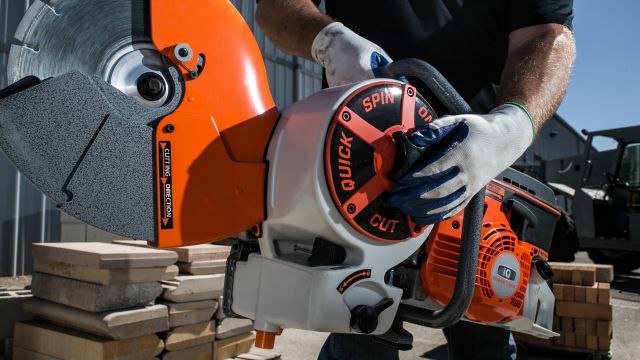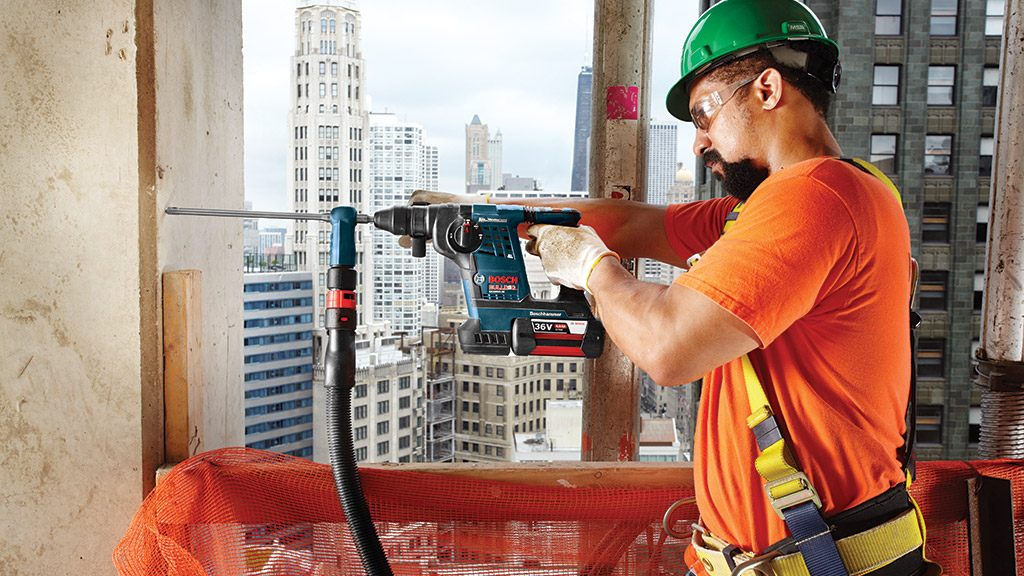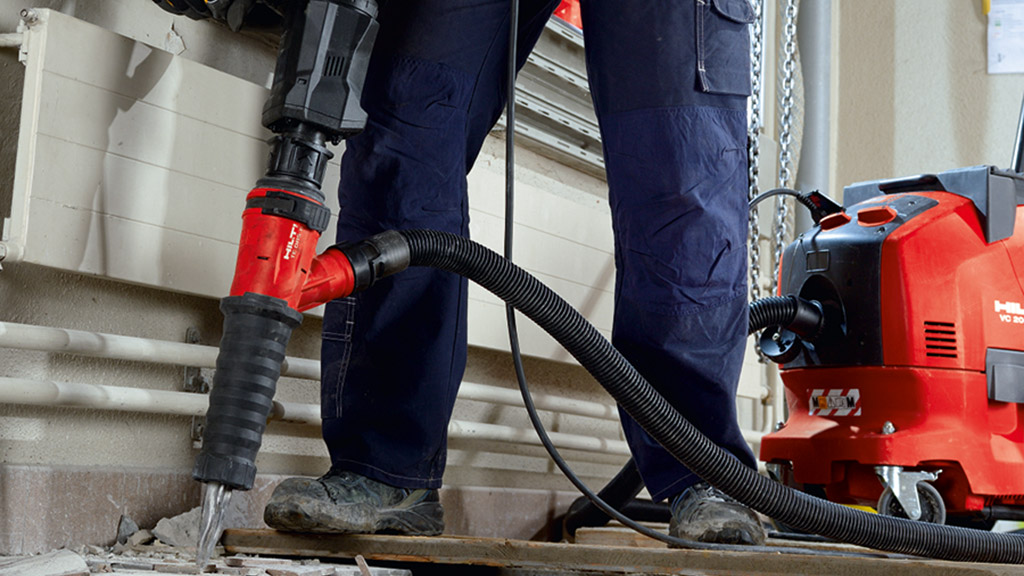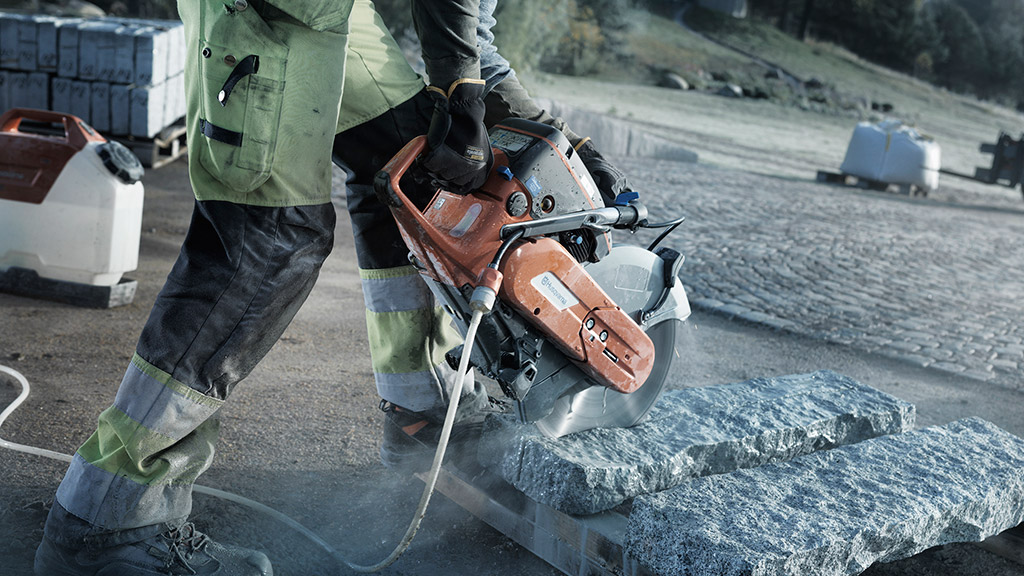iQPC912v Gas-Powered Handheld Power Cutter
June 21, 2016 7:00 AM CDT
With iQ, safety and efficiency go hand in hand. All iQ tools are designed to create a safe work environment for the operator that will meet all OSHA regulations. Operator safety should be the number-one design and use requirement for any tool manufacturer. The iQ company began because there was a need to eliminate a safety hazard (dust and slurry) on jobsites and to help save lives.
According to iQ, testing, recording and documenting the operator’s exposure to potential hazards and developing the proper work process should be mandatory for all tool manufacturers. Per OSHA, it must be part of tool operator training.
iQ has white paper studies to identify the exposure limits to the operator while using iQ tools. The results verify that all of the tools can be used safely and keep the operator below the OSHA permissible exposure limits (PELs). These studies and printed materials are available to contractors and are a necessary component of their safety training program.
iQ is working to provide AHAs (Activity Hazard Analysis) and JHAs (Job Hazard Analysis) that the contractors can use to teach real-life work practices to their crews. The end goal is to teach and train a workforce in the safest and most efficient way to get the job done.
As part of the operator’s manual accompanying every tool, iQ also provides safety training and work process tips. Programs includes dealer training, contractor training, webinars on safe and proper work practices for MCAA, and half-day hands-on sessions.
Website: www.iqpowertools.com
Company Representatives: Joel Guth, president; Stephanie Civello, executive assistant; and Sarah Hurtado, marketing communications manager
Balance benefits the user. When drilling, the operator uses the tool three different ways: above him, in front of him and on the ground. In all three levels of use, the drill can’t have too much weight in either the front or back, so that the operator can maintain full control of the tool.
Vibration control is also important. Bosch uses both active and passive vibration control in its design. Active control is the reduction of vibration from the design of the hammer. The motor and internal mechanics are designed such that the vibration∑ levels are lowered. Passive vibration means that the bridge between the motor and handle has flex to it, allowing the vibration to be dampened when holding the tool. The handle is not attached directly to the motor. All these things add up. Controlled vibration makes the feel of the tool much easier, and it is safer on the hands, arms, etc.
Bosch also considers dust control and meeting UL regulations during design of their tools.
For all new products in the North American market, Bosch releases basic function videos on its website. These provide a general understanding of how to use the tool and the main features, in addition to the very detailed user manual that comes with all Bosch products.
Website: www.boschtools.com
Company Representatives: Mike Iezzi, product manager, corded products and concrete products, and Steve Wilcox, public relations brand manager
The TE 1000-AVR is used for demolishing concrete and masonry at floor level or below waist level. Like other Hilti tools, the breakers have active vibration reduction systems. The handle is decoupled from the motor, with absorbers between the two, so that the vibration is not as heavily transferred to the operator.
Hilti products have been meeting EU standards for some time already, and concurrently selling those products in North America. In design and development of their tools, the company makes a priority not only to follow the current regulations but also to meet the end user’s needs for comfort and safety.
Every tool sold by Hilti comes with an operator’s manual, with instructions for proper use and care of the tool. In that, it says, “By design, this is how the operator should use the tool for maximum comfort and efficiency.”
For additional training, how-to videos on YouTube provide further instruction for some products. However, Hilti’s 1300 direct sales personnel call on contractors regularly, and account managers are available every day to answer operational questions.
Finally, Hilti offers a very low cost of ownership for its tools, making contactors even more productive. The company is very stringent on both quality and lifetime during the design process of its tools. If the TE 1000-AVR breaker fails, for instance, Hilti’s new 20-2-1 warranty provides a 20-year limited warranty, 2 years of wear and tear coverage, and a 1-day repair turnaround. The end user won’t pay any additional costs within the warranty period, including labor, parts and shipping. This helps ensure that Hilti tools achieve the desired level of performance for the entire warranty period.
Website: www.us.hilti.com
Company Representative: Aaron Brading, BU manager for power tools and accessories
Husqvarna designs for reduced dust with every product. Minimum levels set by governing bodies — in particular — the permissible exposure limits (PELs) set by the recently finalized OSHA silica rule — are guidelines that give a more precise indication of how much dust needs to be reduced. Although more vacuum options from Husqvarna are on the way, water is still the major recommended method to reduce dust in this new regulation, and will still be a key reduction technique.
On Husqvarna’s newest masonry saw, the MS 360, for example, a blade guard is specifically designed to keep water more contained, so the brick/block does not become soaked yet there is still dust control.
Another system on the company’s handheld power cutters is a water reduction system called DEX. The system uses 4-gallon spray water bottles, or an optional 4-gallon battery-powered water tank with pressure control (the WT 15). The water reduction system allows the user to operate the system for a longer period of time and results in drier brick or block.
Plenty of safety information is provided in the operator’s manuals, but Husqvarna also trains both its sales force and dealers. All of them are capable of doing “tailgate type” sessions, or setting up safety demos or seminars with contractors. A full program is already put together along with online training videos.
Website: www.husqvarnacp.com
Company Representative: Mark Michaels, director of product management — equipment
At STIHL, it’s important that every product developed not only helps the end user be productive on the job, but also that operators understand how to use the equipment properly. Working with cutoff machines can be a dusty job; that’s why STIHL operator’s manuals give detailed information on maximizing dust suppression. While STIHL gas-powered cutoff machines comply with ANSI B175.4 and come with water attachments designed to help suppress dust, it’s the employer’s duty to provide protective equipment to his or her employees per OSHA regulations.
In addition to the operator’s manual, STIHL makes every effort to provide supplemental resources and instruction for operators of their equipment. It starts with STIHL dealers who are knowledgeable about the products they sell and can give instruction on proper tool usage. In the field and on jobsites, STIHL technical sales specialists are available to further work with companies to train employees about proper use of cutoff machines. Additional materials, including instruction manuals, safety manuals and safety DVDs, can be found both online and through STIHL dealers. All materials are updated regularly to offer the latest recommendations for best work practices.
Not surprisingly, companies using STIHL cutoff machines oftentimes use STIHL’s manuals and videos as the basis for their training programs.
Website: www.stihlusa.com
Company Representatives: Thomas Techow, product manager, and Lindsy Shrewsberry, public relations specialist
The biggest worry with generators is carbon monoxide (CO), because that is what generators produce. Thus, Subaru is very stringent in adhering to OSHA regulations as well as CPSC (Consumer Product Safety Commission) recommendations. Every brochure and every manual from Subaru includes information on how dangerous and lethal CO can be — it can kill within seconds. Manuals contain strong warnings to use the products in a well-ventilated area, not enclosed or occupied.
Subaru gives as much attention to safety as possible. All label warnings are to code and are placed in high-profile locations on fuel tanks, boxes, etc. Specific symbols recognized across the industry are utilized.
In addition to detailed operation instructions in all Subaru product manuals, the company has YouTube videos and training classes for dealers. In the summer of 2016, Subaru is launching an online training program in which dealers will be able to obtain their certifications online rather than in the classroom.
Website: www.subarupower.com
Company Representative: Pam Meyer, equipment sales manager
Safety by Design
Jobsite tools designed to meet the latest standards
By Karen Hickey
Jobsite tools are designed with the operator in mind and to meet the latest standards. Masonry Magazine spoke with six manufacturers about what sets their products apart when it comes to safety, ergonomics, and meeting industry regulations.
Masonry asked the company representatives the following questions:
- How much does ergonomics play into the design of your tools?
- What about meeting the latest industry regulations and standards?
- How has this affected the documentation accompanying the tools?
- Do you offer safety training for users of your tools, or provide tips to those who may teach safety?
iQ Power Tools
Ergonomics is very important to iQ. As construction guys and longtime power tool users, they understand how important feel and comfort are. Finding the right balance and maneuverability of a handheld power tool is key to efficient use of the tool. If a contractor doesn’t feel comfortable, they will not use the tool.With iQ, safety and efficiency go hand in hand. All iQ tools are designed to create a safe work environment for the operator that will meet all OSHA regulations. Operator safety should be the number-one design and use requirement for any tool manufacturer. The iQ company began because there was a need to eliminate a safety hazard (dust and slurry) on jobsites and to help save lives.
According to iQ, testing, recording and documenting the operator’s exposure to potential hazards and developing the proper work process should be mandatory for all tool manufacturers. Per OSHA, it must be part of tool operator training.
iQ has white paper studies to identify the exposure limits to the operator while using iQ tools. The results verify that all of the tools can be used safely and keep the operator below the OSHA permissible exposure limits (PELs). These studies and printed materials are available to contractors and are a necessary component of their safety training program.
iQ is working to provide AHAs (Activity Hazard Analysis) and JHAs (Job Hazard Analysis) that the contractors can use to teach real-life work practices to their crews. The end goal is to teach and train a workforce in the safest and most efficient way to get the job done.
As part of the operator’s manual accompanying every tool, iQ also provides safety training and work process tips. Programs includes dealer training, contractor training, webinars on safe and proper work practices for MCAA, and half-day hands-on sessions.
Website: www.iqpowertools.com
Company Representatives: Joel Guth, president; Stephanie Civello, executive assistant; and Sarah Hurtado, marketing communications manager
Bosch
During the initial design of Bosch’s 36-volt rotary hammer, several factors came into play: the balance of the tool with and without the battery, the placement of the handle and buttons, vibration control, etc. The hammer drill weighs more with the battery in, but the tool still needs a good balance no matter which function is being used.Balance benefits the user. When drilling, the operator uses the tool three different ways: above him, in front of him and on the ground. In all three levels of use, the drill can’t have too much weight in either the front or back, so that the operator can maintain full control of the tool.
Vibration control is also important. Bosch uses both active and passive vibration control in its design. Active control is the reduction of vibration from the design of the hammer. The motor and internal mechanics are designed such that the vibration∑ levels are lowered. Passive vibration means that the bridge between the motor and handle has flex to it, allowing the vibration to be dampened when holding the tool. The handle is not attached directly to the motor. All these things add up. Controlled vibration makes the feel of the tool much easier, and it is safer on the hands, arms, etc.
Bosch also considers dust control and meeting UL regulations during design of their tools.
For all new products in the North American market, Bosch releases basic function videos on its website. These provide a general understanding of how to use the tool and the main features, in addition to the very detailed user manual that comes with all Bosch products.
Website: www.boschtools.com
Company Representatives: Mike Iezzi, product manager, corded products and concrete products, and Steve Wilcox, public relations brand manager
Hilti
Ergonomics have always been critical to Hilti. If a worker’s teeth are chattering, if his hands or even his whole body is shaking, he won’t be comfortable on the jobsite. And if a worker is more comfortable, he can perform a job longer with less fatigue.The TE 1000-AVR is used for demolishing concrete and masonry at floor level or below waist level. Like other Hilti tools, the breakers have active vibration reduction systems. The handle is decoupled from the motor, with absorbers between the two, so that the vibration is not as heavily transferred to the operator.
Hilti products have been meeting EU standards for some time already, and concurrently selling those products in North America. In design and development of their tools, the company makes a priority not only to follow the current regulations but also to meet the end user’s needs for comfort and safety.
Every tool sold by Hilti comes with an operator’s manual, with instructions for proper use and care of the tool. In that, it says, “By design, this is how the operator should use the tool for maximum comfort and efficiency.”
For additional training, how-to videos on YouTube provide further instruction for some products. However, Hilti’s 1300 direct sales personnel call on contractors regularly, and account managers are available every day to answer operational questions.
Finally, Hilti offers a very low cost of ownership for its tools, making contactors even more productive. The company is very stringent on both quality and lifetime during the design process of its tools. If the TE 1000-AVR breaker fails, for instance, Hilti’s new 20-2-1 warranty provides a 20-year limited warranty, 2 years of wear and tear coverage, and a 1-day repair turnaround. The end user won’t pay any additional costs within the warranty period, including labor, parts and shipping. This helps ensure that Hilti tools achieve the desired level of performance for the entire warranty period.
Website: www.us.hilti.com
Company Representative: Aaron Brading, BU manager for power tools and accessories
Husqvarna Construction Products Americas
For Husqvarna, ergonomics has always been a huge building block in the research and development of new products. Form and function have been major factors. Their handheld power cutters offer a high power-to-weight ratio, and also very low vibration levels — the lowest measured on a 2-cycle power cutter. This means less fatigue for the operator, lower exposure to dangerous vibration, and therefore higher production rates.Husqvarna designs for reduced dust with every product. Minimum levels set by governing bodies — in particular — the permissible exposure limits (PELs) set by the recently finalized OSHA silica rule — are guidelines that give a more precise indication of how much dust needs to be reduced. Although more vacuum options from Husqvarna are on the way, water is still the major recommended method to reduce dust in this new regulation, and will still be a key reduction technique.
On Husqvarna’s newest masonry saw, the MS 360, for example, a blade guard is specifically designed to keep water more contained, so the brick/block does not become soaked yet there is still dust control.
Another system on the company’s handheld power cutters is a water reduction system called DEX. The system uses 4-gallon spray water bottles, or an optional 4-gallon battery-powered water tank with pressure control (the WT 15). The water reduction system allows the user to operate the system for a longer period of time and results in drier brick or block.
Plenty of safety information is provided in the operator’s manuals, but Husqvarna also trains both its sales force and dealers. All of them are capable of doing “tailgate type” sessions, or setting up safety demos or seminars with contractors. A full program is already put together along with online training videos.
Website: www.husqvarnacp.com
Company Representative: Mark Michaels, director of product management — equipment
STIHL
Form follows function with every tool from STIHL, including their gasoline-powered cutoff machines. During the design process, STIHL considers factors such as weight, the arrangement of handles, implementation of vibration systems, and even emissions and noise legislation. And while the utility of the machine is always important, comfort features and simple starting procedures are also aspects of the design that aid in ease of operation and maximum control for the operator.At STIHL, it’s important that every product developed not only helps the end user be productive on the job, but also that operators understand how to use the equipment properly. Working with cutoff machines can be a dusty job; that’s why STIHL operator’s manuals give detailed information on maximizing dust suppression. While STIHL gas-powered cutoff machines comply with ANSI B175.4 and come with water attachments designed to help suppress dust, it’s the employer’s duty to provide protective equipment to his or her employees per OSHA regulations.
In addition to the operator’s manual, STIHL makes every effort to provide supplemental resources and instruction for operators of their equipment. It starts with STIHL dealers who are knowledgeable about the products they sell and can give instruction on proper tool usage. In the field and on jobsites, STIHL technical sales specialists are available to further work with companies to train employees about proper use of cutoff machines. Additional materials, including instruction manuals, safety manuals and safety DVDs, can be found both online and through STIHL dealers. All materials are updated regularly to offer the latest recommendations for best work practices.
Not surprisingly, companies using STIHL cutoff machines oftentimes use STIHL’s manuals and videos as the basis for their training programs.
Website: www.stihlusa.com
Company Representatives: Thomas Techow, product manager, and Lindsy Shrewsberry, public relations specialist
Subaru Industrial Power Products
When it comes to designing and manufacturing generators, Subaru Industrial Power Products always has the end user in mind. Factors considered in design include the location of items on the control panel, the position of the recoil, making sure the starter rope is easy to pull and at a comfortable angle, and keeping the machine as lightweight as possible.The biggest worry with generators is carbon monoxide (CO), because that is what generators produce. Thus, Subaru is very stringent in adhering to OSHA regulations as well as CPSC (Consumer Product Safety Commission) recommendations. Every brochure and every manual from Subaru includes information on how dangerous and lethal CO can be — it can kill within seconds. Manuals contain strong warnings to use the products in a well-ventilated area, not enclosed or occupied.
Subaru gives as much attention to safety as possible. All label warnings are to code and are placed in high-profile locations on fuel tanks, boxes, etc. Specific symbols recognized across the industry are utilized.
In addition to detailed operation instructions in all Subaru product manuals, the company has YouTube videos and training classes for dealers. In the summer of 2016, Subaru is launching an online training program in which dealers will be able to obtain their certifications online rather than in the classroom.
Website: www.subarupower.com
Company Representative: Pam Meyer, equipment sales manager
Originally published in Masonry magazine.
About the Author
Karen Hickey is the Editor of Masonry magazine.
























